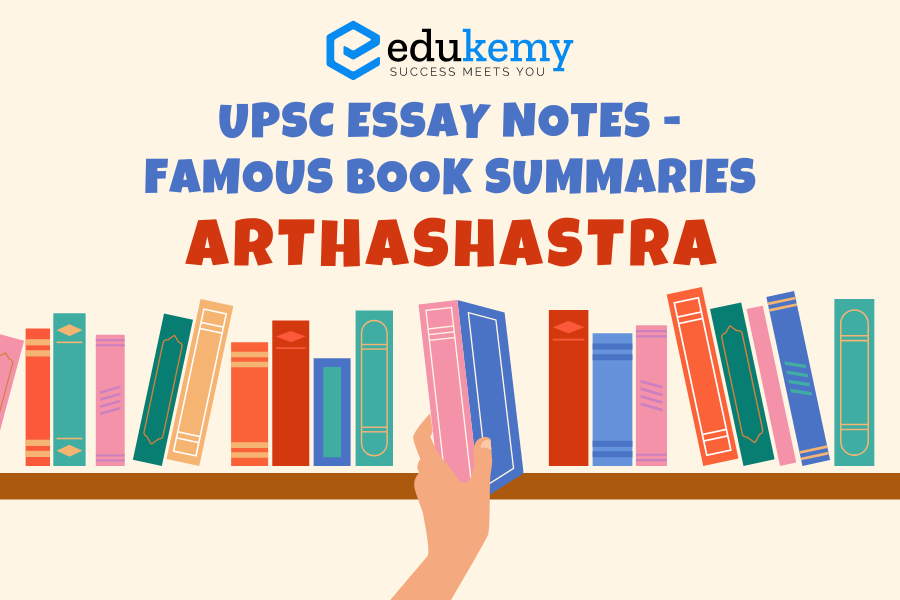
“Within the vast repertoire of study materials for the Union Public Service Commission (UPSC) exams, essay notes serve as indispensable tools for aspirants navigating the complexities of India’s administrative landscape. Among these notes, summaries of seminal texts stand out as guiding beacons, illuminating the intricate interplay of governance, economics, and strategy. One such celebrated work is the ‘Arthashastra,’ attributed to the ancient Indian scholar Kautilya, also known as Chanakya. This classical treatise, composed over two millennia ago, continues to resonate with contemporary relevance, offering timeless insights into statecraft, diplomacy, and the art of governance. Amidst the plethora of UPSC essay notes, summaries of the Arthashastra emerge as essential companions for aspirants seeking a deeper understanding of India’s administrative heritage and strategic acumen.”
This book can be quoted in essays related to Governance, Problem-solving skills in administration, can be used as a way forward.
“Nothing vindicates belief better than reality.”
- A government is good, if it is administered well. Kautilya suggests that “good governance should avoid extreme decisions and extreme actions.” Soft actions (Sam, Dam) and harsh actions (Dand, Bhed) should be taken accordingly.
- ‘Sovereignty is practicable only with the cooperation of others and all administrative measures are to be taken after proper deliberations.’ The King and ministers were supposed to observe strict discipline.
- Kautilya recommended a strict code of conduct for himself and his administrators.
- Kautilya believed in the adage “Yatha Raja Thatha Prajah” (As the King is, so will be the people”). Therefore he laid down the condition that “an ideal King is one who has the highest qualities of leadership, intellect, energy and personal attributes”.
- According to Kautilya, the King had to thoroughly test the integrity of those whom he had appointed. Kautilya also cautioned the dangers inherent in King’s service. Kautilya has seriously considered the problem of corruption. He has listed, in the Arthashastra, about forty ways of embezzling government funds.
Contents
Contemporary Importance:
- In stark contrast to the emphasis that the Arthashastra assigns to rural (village) development, agriculture, and the textile industry, the status quo in India is that these spheres have been neglected. In the sphere of economic administration, India of today has much to learn from Kautilya’s Arthashastra.
- Kautilya recommends severe penalties on the officials of public enterprises which incurred losses, and rewards for those who showed profits. ”Profit” was a “must” in Kautilya’s scheme of running a country’s administration.
- He recommends that public servants, ‘while engaged in work, they shall be daily examined; for, men are naturally fickle-minded and like horses at work exhibit constant change in their temper. Hence the agency and tools, which they make use of, the place and time of the work they are engaged in, as well as the precise form of the work, the outlay, and the results shall always, be ascertained.
- The Arthashastra is very instructive in the context of the conservation of our water resources. It is unfortunate that in India, despite five decades of planning – efficient and equitable water management is still a pipe dream.
Frequently Asked Questions (FAQs)
Q: What is the Arthashastra?
A: The Arthashastra is an ancient Indian treatise on statecraft, economics, and military strategy attributed to Chanakya, also known as Kautilya. It is believed to have been composed around the 3rd century BCE.
Q: What are the main themes covered in the Arthashastra?
A: The Arthashastra covers a wide range of topics, including governance, economics, law, diplomacy, military strategy, and espionage. It provides detailed guidance on how a ruler should govern his kingdom effectively and maintain stability and prosperity.
Q: What makes the Arthashastra significant in Indian history?
A: The Arthashastra is considered one of the most important texts in Indian political thought and administration. Its teachings have influenced the principles of governance in India for centuries and continue to be studied for their relevance in contemporary times.
Q: Does the Arthashastra offer practical advice for rulers?
A: Yes, the Arthashastra is highly pragmatic and offers practical advice for rulers on various aspects of governance, including taxation, law enforcement, diplomacy, and warfare. It provides detailed strategies for dealing with both internal and external threats to the state.
Q: Is the Arthashastra still relevant today?
A: Despite being written over two millennia ago, many of the principles outlined in the Arthashastra are still applicable in modern governance and strategic thinking. Its insights into statecraft, diplomacy, and administration continue to be studied by scholars and practitioners around the world.
To get free counseling/support on UPSC preparation from expert mentors please call 9773890604
- Join our Main Telegram Channel and access PYQs, Current Affairs and UPSC Guidance for free – Edukemy for IAS
- Learn Economy for free- Economy for UPSC
- Mains Answer Writing Practice-Mains Answer Writing
- For UPSC Prelims Resources, Click here

